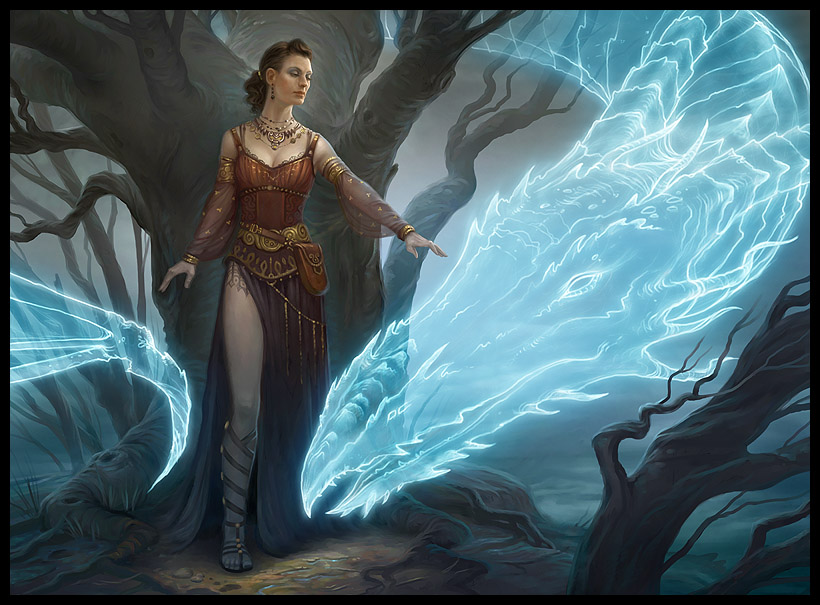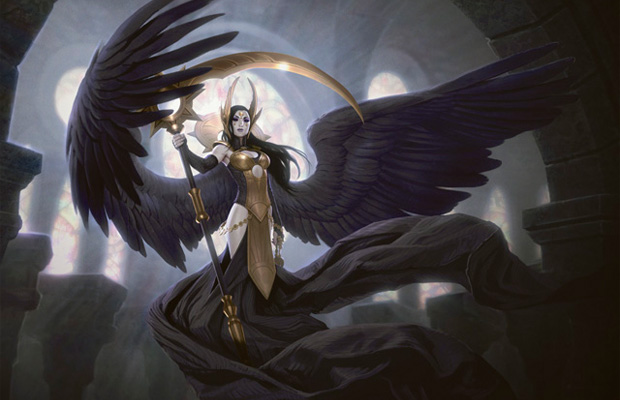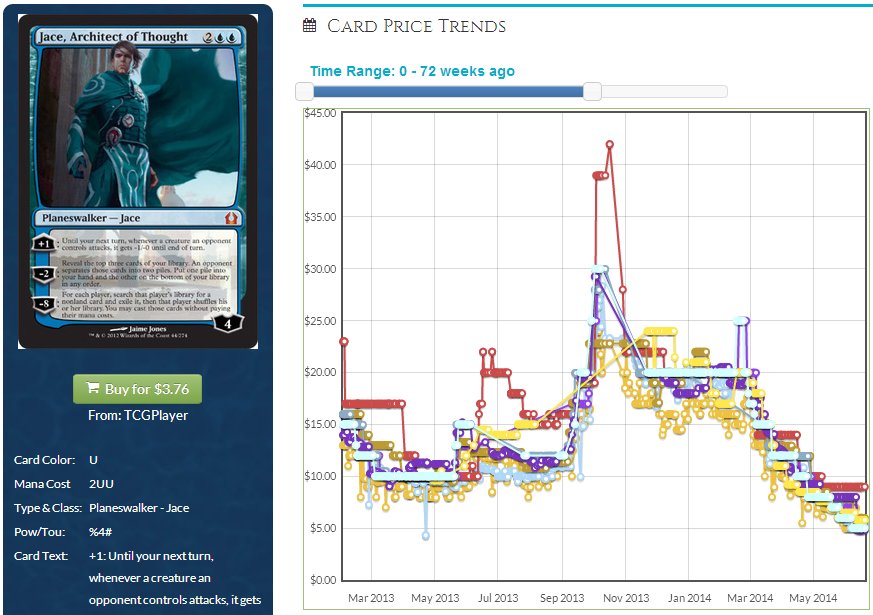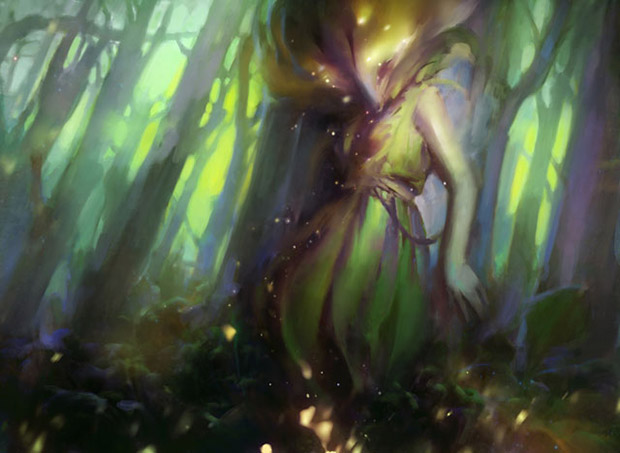By: Jared Yost
The Financially Savvy Planeswalker
Based on the popular website mtgstocks.com one might be lead to believe that our dabbling in the singles market for Magic cards makes use Magic day traders, so to speak. Yes there are similarities but it is in the finer points of the activities surrounding the stock market where the key differences lie.
First, let me draw to your attention the work that mtgstocks and other websites like it (MTGPrice and Quietspeculation included) have done for us since their inception. They are amazing resources that players can utilize to get up to date information on card prices from the vast majority of Magic cards that are out there. Some even offer additional features, like buy list aggregators that let us know where we can quickly buy list any singles we may have been accruing in order to efficiently sell them off to the various vendors. I regularly use both resources in order to see current market trends and to base whether or not my position in the market is suited to what is currently happening. I also use them to put together buy list orders that enable me to sell off cards in bulk for some orders.
What these websites aren’t are E*TRADE, Charles Schwab, or Scottrade. There are many fine differences between buying and selling stocks versus buying and selling Magic cards. I’m going to assume you don’t know anything about the stock market and start from the ground up. Let’s use this getting started with the stock market article by Lifehacker as the starting point. You will need to know about the following in order to invest wisely in the stock market:
Learn the Terminology – In other words, know what words like dividends are and what they offer you when you decide to purchase a stock.
How to Pick the Company (Stock) – Now that you understand the terminology you will need to know how to go about picking exactly which stock you want to buy into and how much of it you are willing to purchase. There are generally two avenues for doing this – growth stocks and dividend stocks. I’ll get into this discussion later on because this is the closest comparison you can make between MTG speculation and the stock market.
Research – Find out about any issues at the companies you want to buy the stock from before deciding if you ultimately want to purchase them. Know when to diversify your portfolio so that you don’t get banged up too badly when a stock you do purchase goes south. Research also heavily relates to MTG and and ties into the second point closely. The distinct difference here is that you are not just picking stocks but picking stocks based on their role in the market and the financials of the company behind the stock.
Utilize Tools – Know which tools are right for you in order to get the most out of your experience buying and selling stocks. These represent everything from Yahoo Finance to systems like E*TRADE where you actually purchase and sell the stocks.
Reading that explanation may make you think that MTG speculation is related in basically every facet to the stock market, especially concerning research and picks. While this may appear to be true on the surface, in reality the little details of the stock market and Magic speculation go in totally different directions.
Let’s dive further into stock market terminology. These are just some of the many facets of a stock you can use to determine if you want to buy or sell it:
Stock Price
Earnings per share (EPS)
Beta
Market Capitalization
IPO
Price to Earnings Ratio (P/E)
Hedge
Margin
Moving Average
Exchange
Volatility
I could go on for quite a while, listing all of the possible information you could use to invest in a stock, but the issue I wanted to highlight is that there are plenty of data points that you could use to make a decision whether or not to invest in a stock. With Magic cards, there are also data points we could use to base our speculation on yet I have a feeling that most speculation is based on a gut reaction to a card – hardly something with concrete evidence to back it up without further defining data points. However, by standardizing certain data points about a card we could go down the path of statistically indicating the probability of a Magic card being good and thus being a good candidate to increase in price. Unfortunately, this almost never works because Magic cards are controlled by a single company rather than a market of potentially thousands of companies. This lack of diversity, along with other issues, leads to many differentiating factors that make Magic speculating much different and even sometimes harder than the stock market.
One vs A Thousand
There is only one company that controls production of Magic: the Gathering cards. Unless the market becomes flooded with counterfeit producers, which would not indicate the end of the game necessarily but would still destroy the secondary market, this fact will continue to influence the prices of Magic cards in a significant way. They make the rules for the growth cards by influencing Standard card pools and Modern reprints, and occasionally shaking up the Legacy banlist.
Since Wizards of the Coast is owned by Hasbro, and Hasbro only shares select pieces of information about Magic card production facts and figures, we can really only base our financial understanding of a growth card on past actions of similar cards or from a deck tech article where the author may or may not even play the deck at the Pro Tour. If someone suggested that I should try to buy a growth stock based on this type of information, I would laugh them out of the room. The odds of buying of a single growth stock and making it work this way are no better than going to a casino and hoping to win a million dollars. It is assuredly a losing game when trying to buy several growth stocks like this.
Dividend cards, on the other hand, offer us another look at the Magic market. Dividend cards are your Legacy Duals lands – pretty much guaranteed to go up until the death of the game. Think Black Lotus, Mishra’s Workshop, and Bazaar of Baghdad – reserve list cards that are played in favorite Vintage archetypes that also have collectible value from being so old and rare. The reserve list is the halcyon of dividend cards. If you want to have a comfortable increase in the value of your collection, targeting reserve list cards is the way to go. Unlike stocks, they aren’t as volatile – there are plenty of companies that pay dividends whose stock has dived considerably. Reserve list cards tend not to do this, at least no overnight like a stock might. In this example Magic seems like a better investment than stocks most of the time if you have the capital and storage (bank lock box) to keep your value. Your market is much smaller than a stock, however, so if you want to liquidate your card it could take a while to find a buyer.
This market restriction presents itself in more than just a lack of information. There is also a lack of resources you can use to sell your cards unlike selling a stock. When I’m on a digital broker, I can sell a stock instantly at the asking price it is listed at – and receive my money as soon as that execution is acted upon. With Magic cards, they can sometimes linger for months if no one wants them. Yes, the buy list is always an option – but there you are leaving more money on the table rather than getting the “market price” of the card where in the case of a stock you sell, you get market price pretty much every time. That also doesn’t indicate the hidden fees and time it takes for the cards to get to you. Of course, some brokers charge a fee every time you execute a sell or buy – others don’t though, so if you are interested in stocks it is usually a good idea to look around first to find a broker that best fits your volume of stock purchases and sells. You don’t have this luxury for Magic buy lists. You always eat the cost of shipping to the buy list, which includes the actual act of shipping the cards and the materials you need to ship them and even insurance.
It also manifests itself in the fact that this is a game rather than a financial vessel. Rather than looking at the cards as dollar bills, they are actually things we can use to play with which means they hold sentimental value to us. Vendors have gotten around these pesky sentimental feelings by going through thousands of these cards a month, however for 99% of the player base we got into this game to play it rather than try to make money off of it.
OK, but Card Prices Do Go Up… And Down (Buy Low)… So Profit?
Yes, that is evident and why I’m so interested in knowing why Magic card prices fluctuate so much and sometimes with only a day’s notice. I didn’t say you can’t make money here however you can’t be in the same mindset of a day trader.
Now I mentioned that there are ways of standardizing data points for cards in order to determine their value. Some of the ways could include:
Age (physical age – as in, Alpha cards tend to be worth the most statistically speaking)
Converted Mana Cost
Set Rarity (common to mythic rare)
Number of Copies per Deck
Color
Crowd Favorite (love from the casuals, tournament crowd, and both crowds)
Format It’s Legal In
Card Type (lands and Planeswalkers are generally worth more)
Number of Articles It’s Mentioned In
Preorder Price
Trade Value
Market Value
These are just the first batch of properties I brainstormed. I’m sure there are more we can use, just like stocks, and some of these properties even contradict each other just like stock properties tend to do. For example, a card might have a low converted mana cost and be a mythic but it might be just a vanilla green creature with two power and toughness. Vanilla guys without synergy in the format are garbage. Generally multiple traits are desirable together yet combine them in the wrong way and all of sudden you have a bulk mythic.
Instead, we need to take into account the synergy of the card within the format it is being played in order to understand its price. Lion’s Eye Diamond, while a rare and having a low converted mana cost, is a terrible card outside of the respective Dredge and Storm Decks it is featured in Legacy. Stocks don’t act like this – yes, you do need to know the other market players (and the similarity here would be similar Magic cards that could potentially fulfill LED’s role like Lotus Bloom) but otherwise the stock basically rises and falls based on its own merits. A company can stand alone, and make changes within itself in order to better compete in the market. Magic cards are immutable and will always stay the same, meaning their value is solely determined by how good their support cards are. Power creep is real in Magic and happens way more than in the real world when suddenly a brand new company, which does all the other same companies could do plus gives you 5% more, just pops up one day. We can’t just expect a card to rise because it fulfills all of our preconceived data points about making sure a card is good – it has to do this and be synergistic or helpful to a format’s metagame.
A Tale of Two Markets
Due to the massive changes that the game has seen over the past three years, more and more people are starting to become interested in the financial side of Magic. This article is a sign post of sorts – warning, danger ahead. Speculation seems sexy and you might think there are ways to game the market like you can with stocks. Unlike stocks, options don’t exist for Magic cards. We can’t short a crappy common when a set is released at the prerelease prices and we certainly can’t short mythics or rares which are almost guaranteed to crash in price in the months following a set’s release. We can’t create packages of cards and price them at a particular value, and then hope that as a group they go up in value based on factors influencing the market. We have all the information that a stock could provide yet with a swing of their Magic(™) wand Wizards can turn the data on its head. We are only left with buying low, selling high and this is something that is generally hard to do even in the stock market.
There are ways to make money off of Magic however they aren’t in the stockholder’s arsenal – they are in the Magic financier’s arsenal. While these two arsenals are similar and share many of the same traits, the finer points are different and need to be considered accordingly in order to make sure you don’t burn yourself out trying to capture the Magic market with the same strategy as a day trader. As long as you take into consideration things like format rotation and synergy of a card you will become a more savvy Magic speculator. Realize that growth stocks are unlike growth cards, and that dividend stocks are different than dividend cards.




